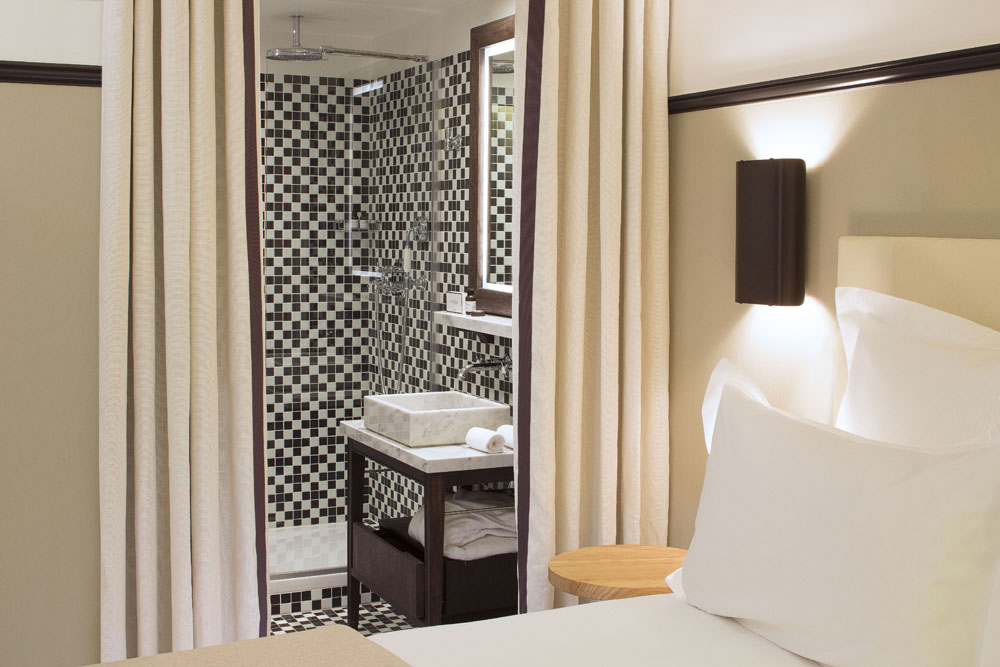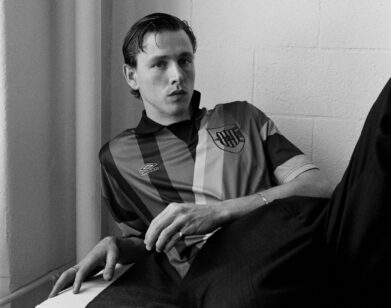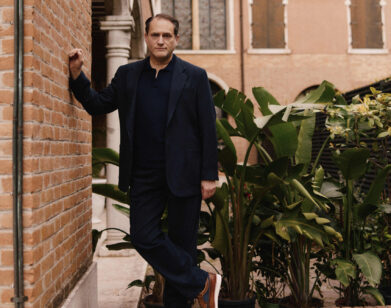Playing with Chess
ABOVE: INSIDE THE CHESS HOTEL.
Interior design duo and life partners Patrick Gilles and Dorothée Boissier began their career in 2004 with residential and restaurant projects. Since then, they’ve grown into designing luxury boutiques for labels like Moncler as well as high-end hotels, like the Baccarat in New York and The Chess Hotel in Paris, where Interview Fashion Director Miguel Enamorado and Senior Fashion and Accessories Editor Julia Gall stayed during Paris Fashion Week. For each project undertaken, Gilles and Boissier aim to create something for not only the client, but also themselves, envisioning a space in which they would feel comfortable and at ease. They invite artists to create site-specific works and design custom furniture fit to each unique space.
At The Chess Hotel, a black-and-white close-up of an owl’s face looks at guests upon arrival from the back wall of the lobby. The mural, painted by Victor Ash, intersects a matching black-and-white tiled floor (aptly reminiscent of a chessboard) and sleekly curved wooden furniture. We spoke with Boissier over the phone about designing the hotel and her and Gilles’ process in general.
EMILY MCDERMOTT: The Chess Hotel is one of the first hotels you ever designed, right?
DOROTHEE BOISSIER: It’s the first one that opened, but the first one on which we worked was the Baccarat Hotel in New York. It took much more time; it took us around four years. When we started working on The Chess, it was maybe three years ago. So we were already starting to be trained working on hotels.
MCDERMOTT: What’s one of the biggest differences from working on a hotel opposed to a restaurant or residence building?
BOISSIER: Before we were doing some residential projects and we were also doing some public projects with restaurants, so I would say the hotel really concentrates on what we used to do in those separate worlds. A hotel is a combination of public and private.
MCDERMOTT: With The Chess Hotel I know you were given carte blanche to do whatever you wanted.
BOISSIER: The Chess Hotel is quite particular because it’s in a small street in a very busy area in Paris. It’s an old building. The entrance was very, very strange because you go through a corridor and then you go directly through a small lobby. The building was in quite a bad shape and for the rooms, we kept the existing layout more or less and the rooms are not so big, so we tried to concentrate on furniture. Because the budget was not so big and because the volume was also not big, we thought what is most important is the furniture which you live on: your bed, your armchair, and a small desk. Those are, I would say, the more important elements. We really tried [to] do a custom design for them and put attention on that.
MCDERMOTT: How did you come up with the theme of chess?
BOISSIER: The theme of chess didn’t come at the beginning. At the beginning we really wanted to do a hotel in which we would love to stay, to be at ease, to come when we are couple, to come with our children, a hotel which was our favorite. I would say the first theme was not to do a chess hotel; it was really to do a hotel created with some artists that we like to work with, with the furniture that we like. And after came the idea of the chess, black and white tiles.
MCDERMOTT: Victor Ash painted the owl mural on the wall. How did you settle upon him as the artist?
BOISSIER: We are always looking after artists, looking at books, exhibitions. When the project is ready and when the artist is really suitable for the project, we try to connect the two, to combine an artist with a project and the location. In the Chess, we had three artists working on the hotel. So Victor Ash did the animal in the lobby and Cyprien Chabert did the courtyard, some carpets, and all the drawings on the doors. This also the way we like to live; when we have friends, artists, coming to the house, [they do] a small drawing, leave, [and] come back. It’s quite a personal view. In our home in Paris we have [a friend who] did some drawings directly on the walls.
MCDERMOTT: What makes you want to have them draw directly on the wall opposed to having pieces framed and hung?
BOISSIER: I think it’s much stronger when the artist is really coming into the décor or really trying to understand the light, the volume, what is around. His implication is really there. Whereas when you buy a piece, you put it wherever you want, which could work also, but it’s not the same language. Giving an artist more freedom to express himself and showing him exactly what he would use, it’s something very different.
MCDERMOTT: Is there any one unifying approach that you have, no matter what kind of project you are working on, in terms of it bring residential, a restaurant, or a hotel?
BOISSIER: When the client comes to us and explains the project, and after we come back to him with the design and concept, we try to be honest and very close to what the client wants. This is the approach we always have. We also always try to invent a story. As soon as we have a story and the concept, then the project is saying something different; it’s not just a nice project but a project that really has something to say.
MCDERMOTT: What is the story behind The Chess Hotel?
BOISSIER: The Chess Hotel is our space, so it was a very personal work to do here. At the beginning we said we wanted to do our hotel, because as the budget was not so high, it was something that we could imagine as being our hotel.
FOR MORE ON THE CHESS HOTEL, VISIT ITS WEBSITE. FOR MORE ON GILLES AND BOISSIER, CLICK HERE.







